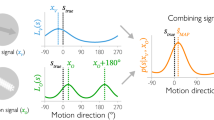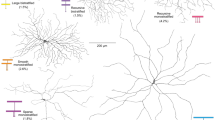Abstract
When elements of a parallel network, such as the human brain, are extensively interconnected, the network can exhibit ‘cooperative behaviour’. Such behaviour, which is characterized by order-disorder transitions, multi-stable states, and a form of memory called ‘hysteresis‘, has been observed in human stereopsis1,2 and has motivated models of stereopsis that incorporate cooperative networks3–6. More recently, cooperative phenomena have also been observed in human visual motion perception7. This report strongly supports a cooperative interpretation of motion perception by demonstrating hysteresis in the perception of motion direction. The results agree quantitatively with a mathematical model incorporating nonlinear excitatory and inhibitory interactions among direction-selective elements.
This is a preview of subscription content, access via your institution
Access options
Subscribe to this journal
Receive 51 print issues and online access
$199.00 per year
only $3.90 per issue
Buy this article
- Purchase on Springer Link
- Instant access to full article PDF
Prices may be subject to local taxes which are calculated during checkout
Similar content being viewed by others
References
Julesz, B. Am. Sci. 62, 32–43 (1974).
Fender, D. H. & Julesz, B. J. Opt. Soc. Am. 57, 819–830 (1967).
Sperling, G. Am. J. Psychol. 83, 461–534 (1970).
Wilson, H. R. & Cowan, J. Kybernetik 13, 55–80 (1973).
Marr, D. & Poggio, T. Science 194, 283–287 (1976).
Mayhew, J. E. W., Frisby, J. P. & Gale, P. Perception 6, 207–208 (1977).
Chang, J. J. & Julesz, B. Vis. Res. 24, 1781–1788 (1984).
Williams, D. W. & Sekuler, R. Vis. Res. 24, 55–62 (1984).
Baker, C. L., Jr. & Braddick, O. J. Vis. Res. 22, 1253–1259 (1982).
Williams, D. W., Tweten, S. & Sekuler, R. Invest. Ophthalmol. vis. Sci. Suppl. 25, 14 (1984).
Feldman, J. A. & Ballard, D. H. in Human and Machine Vision (eds Beck, J., Hope, B. & Rosenfeld, A.) 107–155 (Academic, New York, 1983).
Author information
Authors and Affiliations
Rights and permissions
About this article
Cite this article
Williams, D., Phillips, G. & Sekuler, R. Hysteresis in the perception of motion direction as evidence for neural cooperativity. Nature 324, 253–255 (1986). https://doi.org/10.1038/324253a0
Received:
Accepted:
Issue Date:
DOI: https://doi.org/10.1038/324253a0
This article is cited by
-
Single trial neuronal activity dynamics of attentional intensity in monkey visual area V4
Nature Communications (2021)
-
Trial by trial dependencies in multisensory perception and their correlates in dynamic brain activity
Scientific Reports (2018)
-
Dynamic Stress–Strain Behavior in ZrTiCuNiAl Noncrystalline Alloys Pretreated Under High Pressures
Metallurgical and Materials Transactions A (2015)
-
Serial dependence in visual perception
Nature Neuroscience (2014)
-
Stability and change in perception: spatial organization in temporal context
Experimental Brain Research (2005)
Comments
By submitting a comment you agree to abide by our Terms and Community Guidelines. If you find something abusive or that does not comply with our terms or guidelines please flag it as inappropriate.



